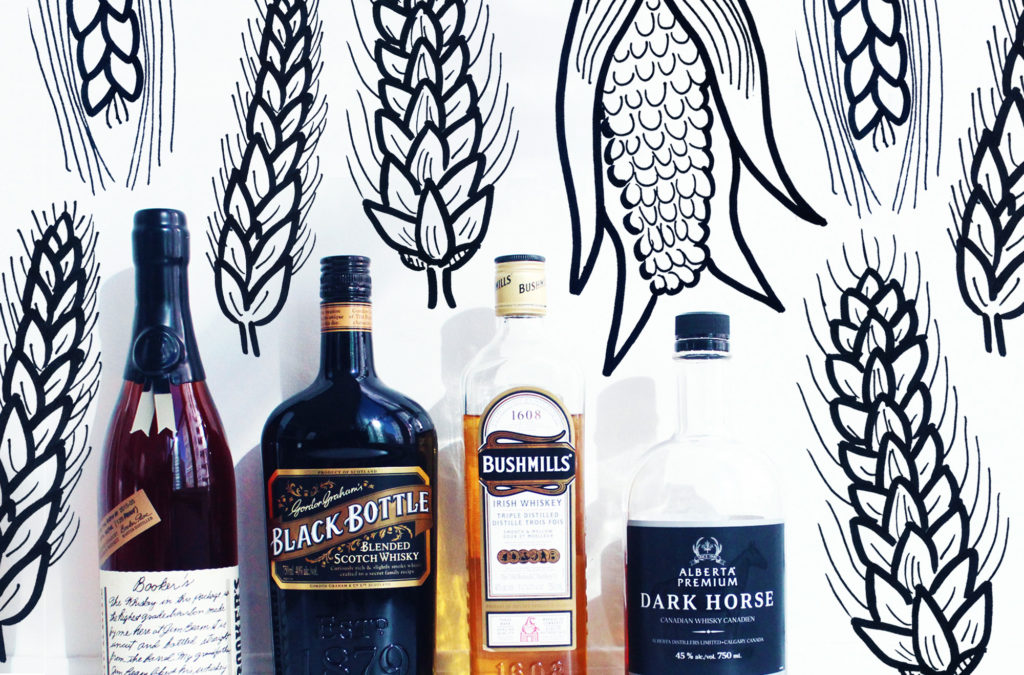
Hello darling,
I see that you like whisk(e)y and are looking to learn more. Well, you’ve stopped in the right place!
Nine months ago, I launched Whiskey Muse as a way to hold myself accountable to learning about the “water of life”. After reading countless articles and books, travelling far and wide from Kentucky to Ireland, taking whisk(e)y certifications around the world, and chatting with experts, connoisseurs, master distillers and whisk(e)y social media influencers, I have gleaned an enormous amount of knowledge about the wonderful world of whisk(e)y which I am excited to share with you. I still consider myself a novice, however, I feel that this guide will provide a modern + fresh take on whisk(e)y and help you to navigate and more importantly, understand, the basics of this incredible spirit.
This complete and comprehensive guide will teach you all of the basics you need to know all about whisk(e)y in a fun and interesting way.
This beginner’s guide will teach you:
- The origins of the word whisk(e)y and where it came from (and the right spelling for it)
- What whisk(e)y is made from
- How to make whisk(e)y
- The main types of whisk(e)y + flavour profiles
- How to drink whisk(e)y
- Which whisk(e)y to try first
- Key terminology (to make you sound like you know what you’re talking about)
Sound good? Excellent. Now without further ado, here is the Whiskey Muse’s Whiskey Guide for Beginners.
NAME + ORIGINS
The word whisk(e)y is the anglicized (read: to make more English) version of the Gaelic word “uisce” which comes from “uisce beatha” of which “uisce” means “water” and “beatha” means “life”. While phonetically it makes sense, ironically, (pro-tip coming at you here…) you would actually pronounce uisce beatha traditionally as “ish-ga bah-ha” or “wish-ga bah-ha”.
Now I know what you’re thinking – what’s the deal with that bracketed “e” in the word whisk(e)y? As you know there’s differences in the way in which whisk(e)y is spelled which is no different from its origins’ namesake. While the Irish translated “water of life” as uisce beatha, the Scottish translated the spelling to be uisge beatha.
So what’s the right spelling of the modern version? As a rule of thumb, whisky and whiskey are one in the same. However, certain countries have certain preferences on the spelling.
How can one remember which is which? A quick little trick is to remember that:
- Countries with the letter “e” in them (e.g. United States + Ireland) spell it whiskey (and the plural whiskeys)
- Countries without the letter “e” in them (e.g. Scotland, Canada + Japan) spell it whisky (and the plural whiskies)
This is not to say that there aren’t exceptions to the rules. For example American bourbon producer Maker’s Mark spells it without the “e” on their labels. And while this rule of thumb holds true for these five main whisk(e)y producing countries, the rest of the whisky-producing world pretty much spells it without the “e” (e.g. Germany, Australia, France, Taiwan, India etc.).
Nevertheless, going back to the water of life, it is said that Irish Monks first invented whisk(e)y back around the 15th century after learning distillation techniques from the east. While these distillation techniques were developed to make perfumes and aromatics, medieval monasteries began to use distillation to create the water of life as a medicinal healing tool for things like smallpox.
While the idea of drinking whiskey as a medicine sounds appealing, at this point in time they hadn’t figured out that aging it in barrels makes it taste a lot better. The rough, fresh off the still, undiluted distillate would often be drank straight. So monks and farmers would put other ingredients like honey, herbs, berries, spices, or to use the more fancy word, botanicals, to smooth it out and make it drinkable.
At this point you may be thinking, “wait a second, this doesn’t sound like whisk(e)y at all. Unaged? Botanicals? This sounds like a gin!” And you’d be right – the style in which it was made was much more reminiscent of what we would classify as a “gin” of today. But alas, I digress.
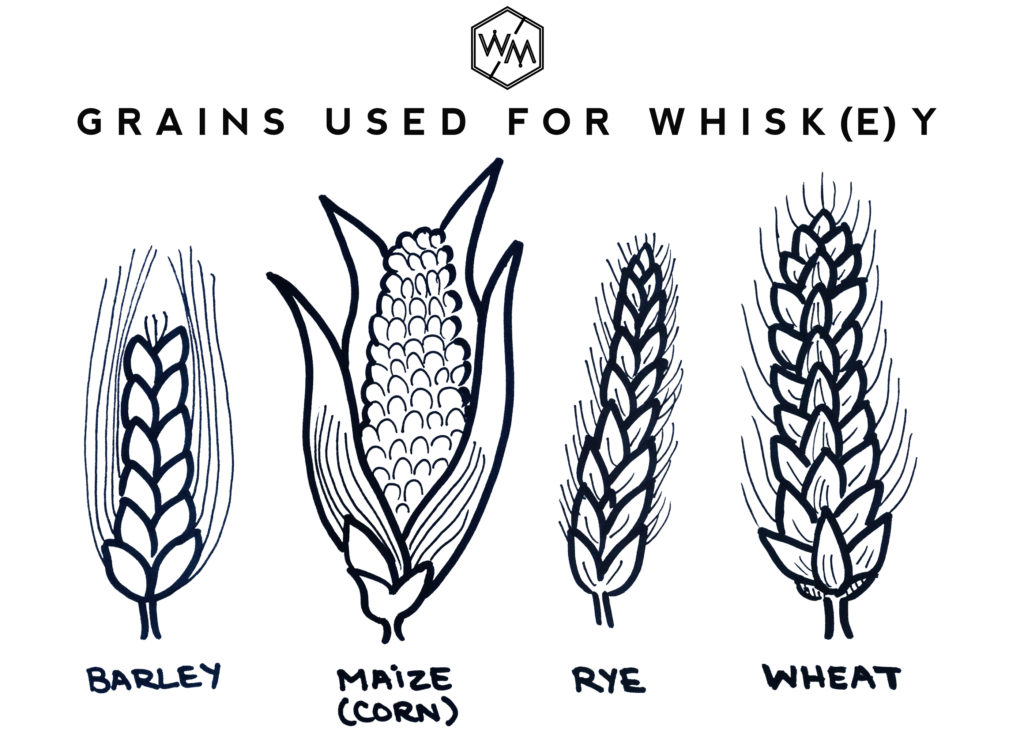
WHAT WHISK(E)Y IS MADE FROM
Depending on who you ask, whisk(e)y is made from four key ingredients: cereal grains, yeast, water, and time (spent aging in barrels).
The most common cereal grains used to make whisk(e)y are Barley, Corn, Rye + Wheat with the majority of whisky around the world having a base of either Barley or Corn. But we’ll get to that in more detail later.
To give you the two cent tour of how whisk(e)y is made:
- Hot water is added to the ground up (or milled) grains, creating a “mash” which is cooked and the enzymes (which are added in in the form of malted barley or synthetic enzymes) begin to convert the starches from the grains into sugars.
- Yeast is added to the mash and the mixture begins to ferment in which time the yeast starts eating all of the sugars. These sugars cause it to burp out CO2 and poop out different types of alcohols. Now once all the poop aka alcohols have been released and the fermentation is complete (this typically takes about 3-7 days)
- The resulting liquid is essentially a distiller’s beer. While at this point brewers would carbonate the liquid, bottle it and call it a day, distillers have a much longer journey to go.
- The Master Distiller takes this beer and puts it in either a pot still, column still or a hybrid. The beer is then typically distilled a number of times depending on what type of whisk(e)y is being made. Each time it is distilled more of the “bad alcohols” aka congeners aka the flavouring alcohols are removed and the clean “heart” of the mixture, ethanol, is extracted. In addition to the “bad alcohols” being removed, water is also removed as well making each subsequent distillation a higher percentage of alcohol (ABV).
- Once the Master Distiller has finished distilling, the alcohol is then put into barrels (usually oak) and aged anywhere from two years to thirty years on average.
- These barrels are then mixed together to create a special “flavour profile” for the whisky. The whisk(e)y is then bottled and is ready to be drank by consumers everywhere!
Now if this is still a bit confusing to you, I’ve drawn you a handy dandy chart below. Click on the image to zoom in to the descriptions below each stage of the whisk(e)y making process.
WHISK(E)Y TYPES
The way in which whisk(e)y is classified is a bit of a mixed bag. Because whiskey can be created anywhere in the world, there are numerous types and styles that have been created globally. Some of the ways in which whisk(e)y categories can be determined are:
- By Country/Region (e.g. Scotch, Bourbon, Single Pot Still, Tennessee Whiskey etc.)
- What Grain(s) They’re Made Of/How the Grains are Treated (Rye, Malt, Single Grain etc.)
- How Long They’re Aged For (e.g. Straight Bourbon)
- What They Do Once They’re Ready to Bottle (e.g. Blended, Single Barrel, Cask Strength etc.)
Now if you’re interested in learning a more detailed account of all the different types of whiskeys/whiskies there are, you can do so in the article “The Comprehensive Guide to Whisk(e)y Styles” coming soon. I’ll be covering all of the types of whisk(e)y in the image below. However, for the purpose of this article, we will cover the six (and a half) types in yellow in the image below. Before we dive into them, I want to address something: Scotch.
People will often compare Scotch to bourbon or Scotch to rye when that’s not an entirely fair comparison.
Scotch isn’t a type of whisky per se it’s more of a category. The Scots have done an incredible job in making a name for their country’s whisky, however, “Scotch” refers to any type of whisky that is produced in Scotland just as any whiskey produced in Ireland would be considered “Irish Whiskey” or any whisky produced in Canada can be called “Canadian Rye Whisky” – but that’s another story for another time.
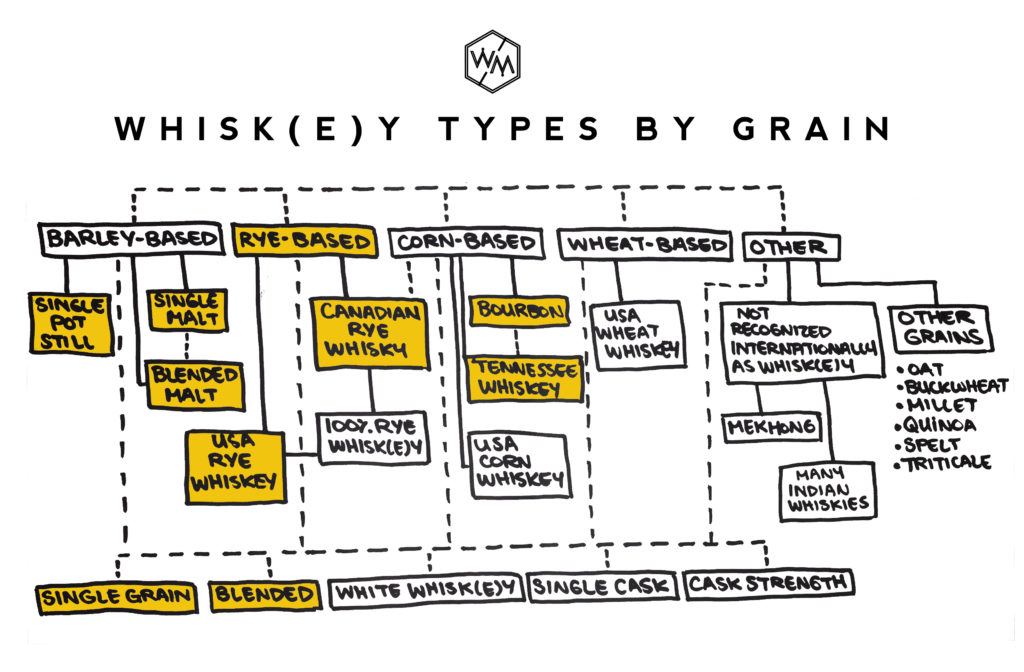
In the following section I will be giving you a brief overview of the following types of whisk(e)y: Bourbon, Tennessee Whiskey, Rye Whisk(e)y, Malt Whisk(e)y, Grain Whisk(e)y, Single Pot Still Whiskey and Blended Whisk(e)y.
A) BOURBON
According to US regulations, in order for something to be considered a Bourbon it has to meet five requirements: it has to be made in the USA, made from at least 51% corn, distilled to no higher than 160 proof, put into a barrel at no higher than 125 proof and is put into a new, charred oak container.
If you didn’t catch that – there’s no aging requirements and no, it doesn’t have to be made in Kentucky. That being said, there are a few things to note:
- If you want to call your bourbon a “Kentucky Bourbon,” it needs to be aged at least one year
- If you want to call your bourbon a “Straight Bourbon,” it needs to be aged for at least two years
- If your straight bourbon is aged for less than four years, you MUST put an age statement on the bottle
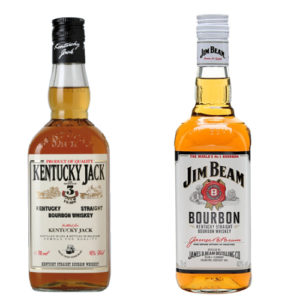
Pop Quiz: Which one of these Kentucky Straight Bourbons are older? Answer: Jim Beam. As noted above, because Jim Beam has no age statement on the bottle, it has to have been aged a minimum of four years or more.
Because bourbon is made from a corn base, typically double distilled and aged charred oak barrels, a few of the common flavour characteristics of bourbons are: Caramel, Vanilla, Honey, Brown Sugar, Cinnamon, Spice, Fruity, Nutty, Oaky/Woody + Corn.
Some well known Bourbon brands include: Jim Beam, Maker’s Mark, Bulleit Bourbon, Woodford Reserve, Buffalo Trace, Wild Turkey and Pappy Van Winkle.
A2) TENNESSEE WHISKY
While Tennessee Whiskey technically falls under the “bourbon” category as Tennessee whiskeys meet the five requirements to be a bourbon, the main differences are that (1) it’s specifically produced in Tennessee and (2) it undergoes something called the “Lincoln County Process” in which the whiskey is sugar maple charcoal filtered before it is put in barrels to age.
This “sugar maple charcoal filtering” sounds pretty sexy but in reality this is what actually happens. The distilleries will buy sugar maple timbres and light them on fire until they are charred. Then those timbres are chopped up into little wood chips and added to a vat. The whisky is dumped (or slowly released) into the vat and the charcoal-chips filter out impurities.
Because Tennessee Whiskey is made from a corn base and further filtered, a few of the common flavor characteristics are: Vanilla, Honey, Sugar, Caramel, and Maple/Maple Syrup.
Some examples of Tennessee Whiskey include: Jack Daniels and George Dickel.
C) RYE WHISK(E)Y
There are two main types of Rye, Canadian and American Rye. While you’d think they would have similar requirements, they are actually quite different.
Within Canada, anything that is labelled “Canadian Whisky”, “Canadian Rye Whisky” or “Rye Whisky” is interchangeable and in fact, doesn’t even need to use rye in it to use those labels, rather it must simply “possess the aroma, taste and character generally attributed to Canadian whisky.” Sure, that sounds a bit ridiculous but Canada is making amends to their reputation. There are a number of fantastic high rye (I’m talking 90+% rye in the mashbill) whiskies coming out of Canada right now.
While Canada is a bit more relaxed with their naming convention requirements, in the USA, similar to bourbon, in order for something to be considered a “Rye” whiskey it must be made of at least 51% rye, be distilled to no higher than 160 proof and aged in charred new oak barrels at no more than 125 proof.
Rye whiskies that are made from 51%+ rye of which a few of the common flavor characteristics are: Spicy/Peppery, Hot, Earthy, Baking Spices, Bready, Dry Herbs and Pickle-y (don’t ask me, I just found pickle-y as a descriptive word for a number of ryes).
Examples of well known Ryes include: Bulleit Rye, Knob Creek Rye, Sazerac Rye, Canadian Club 100% Rye, Alberta Premium and Dark Horse Rye.
D) MALT WHISK(E)Y
Malt whiskies must be made from 100% malted barley and distilled in a pot still. They are double or triple distilled (in Scotland typically double distilled whereas in Ireland they are typically triple distilled).
The process of malting a grain includes soaking the grain (in this case barley) which tricks it into beginning to grow/sprout (germinate). During germination the husk begins to break down and the grain produces enzymes to help convert the grain’s starches into sugars. However, before it can grow into a plant, the process is halted by drying out the grains.
As you know, one of the things that Scotland is known for is peated or smoky whiskies. These smoky whiskies make up a very small part of Scotland’s overall scotch industry and are typically produced by distilleries located in Islay (pronounced EYE-LUH) or the Scottish Islands (i.e. Skye, Jura, Arran, Orkney, Mull etc.). Now, these whiskies get their smoky characteristics from the drying process. The malted barley is dried over a peat fire (peat is a brown soil-like material that is composed partially of decaying vegetables/organisms). The smoke from the peat fire (which contains a chemical compound called a phenol) is absorbed by the barley giving it a smoky flavour which carries through to the finished product.
Now, there are two main different types of malt whisk(e)y: Single Malts and Blended Malts – and it can be a bit confusing remembering which is which. While it’s true that Single Malts only use a single malted grain in their mash, the “Single” refers to it being made at a SINGLE DISTILLERY. Blended Malts still only use a single grain (barley) in their mashes but are produced at MULTIPLE DISTILLERIES and then blended together.
To re-iterate, typically when someone refers to a “Malt Whisk(e)y” or “Single Malt Whisk(e)y”, they mean one that is made from 100% malted barley. However all grains can be malted and there are examples out there of 100% malted rye whiskies or whiskies made from barley, rye and wheat that have all been malted. So as long as you’re not from Scotland (as in their statute it explicitly states barley), you could technically call your whisk(e)y a “Single Malt” as long as it was made with 100% malted grains.
Now there is an entire spectrum of different flavour profiles for Malt Whiskies depending on where they’re made, how long they’re aged for and how the barley is prepared. That being said, some of starting points to the flavour spectrum include: Bold vs. Light, Smoky vs. Mellow, Malt vs. Wood and Ripe (Mature) vs. Fresh (Green).
Example of well known Malt Whiskies include: Macallan, Glenlivet, Glenfiddich, Bowmore, Ardbeg (all from Scotland), Bushmills 10 Year, Tyrconnell (from Ireland), Glen Breton and Shelter Point Single Malt (from Canada).
E) GRAIN WHISK(E)Y
Grain Whiskey is made from one or more cereal grains. This most commonly includes corn, rye, wheat and unmalted or malted barley. While malted barley can be used as part of grain whiskey, it must use another grain as well. As long as it’s not made with 100% malted barley, it can be considered a grain whiskey. In addition grain whiskey is typically made in a continuous still (also known as a Coffey still) as opposed to a pot still (if you’re wondering what the difference between these stills are, there are brief definitions at the bottom of this article).
In Ireland in order for something to be considered a Grain Whiskey it is required to be made in a continuous still and have no more than 30% of the mash bill be malted barley.
Because Grain Whiskey is typically distilled in a column still (which is faster and yields a higher alcohol content distillate but in exchange creates a less flavourful whiskey), it is less commonly bottled and sold on its own. Instead, it is used to be blended with malt or pot still whiskies to create a blended whiskey.
There are two main types of grain whiskey, Single Grain and Blended Grain. Single Grain whiskies do not refer to the distillery using a single grain to make the whiskey but rather it being made at a SINGLE DISTILLERY. Blended Grain Whiskey on the other hand, is a blend of two or more single grain whiskies from DIFFERENT DISTILLERIES.
In comparison to Malt Whiskies, Grain Whiskies tend to be: Light, Clean, Mild, Sweet and Floral.
Examples of Grain Whiskies include: Haig Club,Compass Box Hedonism and North British Whisky (all from Scotland), Teeling Single Grain Whiskey and Glendalough Double Barrel Single Grain (from Ireland).
F) SINGLE POT STILL WHISKEY
In order for a single pot still whiskey to be considered a pot still whiskey it must be made in Ireland, made from a combination of malted and unmalted barley and distilled in pot stills.
How do each of these types of barley affect the final product? Well malted barley is typically known for adding a biscuity/malty aroma to some whiskeys while unmalted barley is usually known for contributing a spicy and mouth-coating texture to the whiskey.
Some of the common flavour characteristics among Single Pot Still Whiskeys are: Oily/Creamy, Biscuity, Leathery, Cocoa, Apricot/Peaches, Tropical Fruits, Honey + Baking Spices (Cloves).
Examples of Pot Still Whiskeys include: Greenspot, Yellowspot, Red Breast (12, 15 and 21) and Midleton Barry Crocket Legacy.
G) BLENDED WHISK(E)Y
Blended whiskey is when two or more types of whiskies are blended together to create a final product. While the definitions for what a blended whiskey is varies depending on country, typically to create a blended whisky a “base whiskey” which is less flavorful but cheaper to produce is blended with a “flavouring whiskey” which is higher quality but more expensive to produce.
How does this look country to country?
In Scotland, there are three types of blended whiskies: Blended Malt, Blended Grain and Blended Scotch Whisky. Blended Malts are when two or more Single Malts from different distilleries are blended together. Blended Grains are when two or more Single Grains are blended together from different distilleries. Blended Scotch Whiskies are when a Single Malt from one distiller is blended together with a Single Grain from another distillery. For Blended Scotch Whiskies the “base whisky” is typically a Grain Whiskey and the “flavouring whisky” is typically a Malt Whiskey.
In Ireland, there is only one type of blend: Blended Irish Whiskey. Blended Irish Whiskeys are when two or more Pot Still, Malt or Grain Whiskeys are blended together. The “base whiskey” would typically be a Grain Whiskey and the “flavouring whiskey” would typically either a Malt Whiskey or Pot Still Whiskey.
In Canada, most whiskies are blended, using a high-proof grain whisky (typically corn-based and distilled in a column still) that acts as the “base whisky” with a lower-proof grain whisky made from rye, barley or wheat (that is often distilled in a pot still) that acts as the “flavouring whisky”.
In the USA, blended whiskey must contain between 20% – 50% straight whiskey (which is any malted or unmalted grain that’s been distilled no higher than 80% ABV and then aged for no less than 2 years at a maximum of 62.5% ABV). If the blend has more than 51% of any one straight whiskey, that cereal grain must be listed on the label (i.e. “Blended Corn Whiskey”).
Some common characteristics among blended whiskies include: Balanced, Light-bodied, Cerealy, Smooth, Toasty, and Honeyed.
Some examples of Blended Whiskies are: Crown Royal (Original), Canadian Club (Original), Johnnie Walker Blue Label, Hibiki Harmony, Jameson (Original), Tullamore D.E.W. (Original), Ballantines and Toki Japanese Whisky.
A bit confused on how these types are related to varying whisk(e)y producing countries? Here’s what countries produce what:
And if you’re still confused about how to differentiate between Single Malts, Blended Malts, Single Grains, Blended Grains and Blended Whiskeys, below is a chart to help explain:
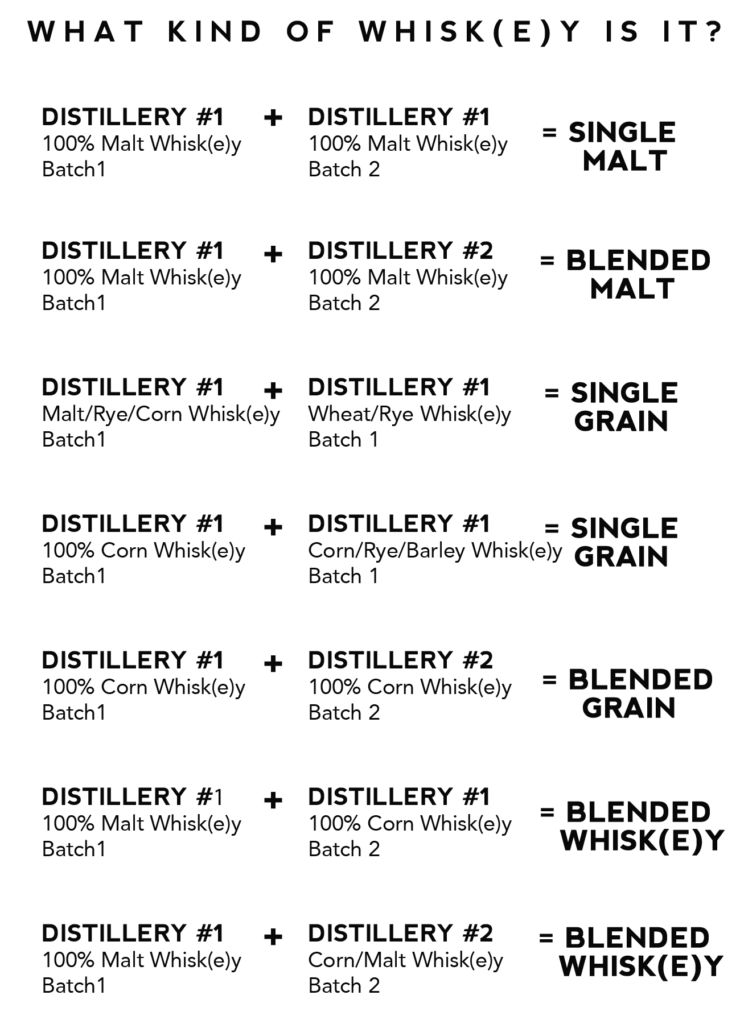
HOW TO DRINK WHISK(E)Y
There is a big difference between tasting and drinking whisk(e)y. With tasting, you intention is to tap into your taste and smell sensories to uncover the different flavours within the spirit. With drinking whiskey, it more of an overall experience where you’re enjoying the drink, the ambiance and the company.
For tasting whisk(e)y I would suggest trying it neat first, then adding no more than a capful of water to allow the whisk(e)y to open up and reveal additional flavours. In addition, there are different types of glassware that you can employ that help to focus the aromas when tasting. Some popular ones include Copita (or ISO glasses) and Glencairn glasses. Both have a tulip-like shape with a smaller opening that concentrates the aromatics and allows one to nose (read: smell) the spirit. Check out more glassware options here.
As for drinking whisk(e)y, you can drink it however the hell you want. However a few common ways that people will drink their whisk(e)y is:
- Neat: Just as it was made. Poured straight from the bottle, into a glass. No additives required.
- With Water: Always ask for the water on the side so you can add as much or as little as you’d like. If possible, go with bottled water as opposed to tap – not because you want to be a snob but because there are less impurities in bottled that will affect the flavor of the whisk(e)y.
- On the Rocks: This means with ice. You can also specify how many ice cubes you’d like or ask your bartender if they have large cubed / spherical ice. The larger the cube, the slower it will melt which means the slower it will dilute the whisk(e)y.
- As a Shot: Reserve this for cheaper whiskies. Whether it’s a straight shot or a mixed one, you can get some creative shot ideas here.
- With Coke: The “gateway drink” to enjoying whisky. The acidity and sweetness from the coke compliments whiskey well.
- With Gingerale: A “rye and ginger” is a common order. The spiciness of the rye is complemented by the kick from the gingerale. It works well together. Ask for a bit of bitters in it too. It’s a game changer.
- In a Cocktail: There are many well known whisk(e)y-based cocktails. Check out the round up of the Top 13 Whisk(e)y Cocktails You Need To Know here.
All-in-all don’t let anyone tell you how you should or shouldn’t drink whisk(e)y because it’s all up to you and your preferences. If you want to drink it with green tea, go drink it with green tea (but like actually, if you want to there’s some great recommendations on which whiskies pair well with green tea in Dave Broom’s Whisky The Manual).
WHAT WHISK(E)Y TO TRY FIRST
You’ve made it this far into the article and you’re probably thinking “okay, so I know where the name came from, how it’s made, what it’s made from, how it’s classified and how to drink it… but where the heck do I start!?”
If you haven’t drank a lot of whisk(e)y in the past, there are a few things that may be off putting. When you start drinking alcohol that’s 40+% ABV (alcohol by volume) straight, it’s going to burn. The only way to get past this is to (1) dilute it or (2) keep drinking a lot of it over time until it doesn’t burn anymore.
When easing into whisky, I would suggest that you explore the full spectrum of types of whisky, but ease into the process with ones that are sweet, subtle and only slightly smoky. As your palate evolves you’ll start progressing into other genres of flavor while continuing to appreciate the intricacies of a smooth and mellow dram.
Some of the starting points for varying types of whiskies are:
Canadian Whisky
Forty Creek Copper Pot Reserve [Bold + Spicy]
Collingwood [Medium + Sweet]
Pike Creek Double Barrel [Bold + Fruity]
American Bourbon / Tennessee Whiskey
Makers Mark [Medium + Sweet]
Basil Hayden [Subtle + Spicy]
Wild Turkey 101 [Medium + Sweet]
Bulleit Bourbon [Medium + Sweet]
Jack Daniels [Medium + Sweet]
Ryes (Canadian + American)
Rittenhouse Straight Rye [Medium + Sweet]
Sazerac 6 Year Straight Rye [Bold + Spicy]
Crown Royal Northern Harvest Rye [Medium + Spicy]
Lot No. 40 [Bold + Spicy]
Irish Whisky
Jameson Black Barrel [Medium + Fruity]
Tullamore Dew [Subtle + Fruity]
Bushmills Black Bush [Medium + Spicy]
Single Malt Scotch
Glenlivet Founders Reserve (Speyside) [Medium + Fruity]
Auchentoshan American Oak (Lowlands) [Subtle + Sweet]
Aberfeldy 12 Year (Highlands) [Subtle + Fruity]
Highland Park 10 Year (Islands) [Medium + Smoky]
Bowmore 12 Year (Islay) [Bold + Smoky]
Blended Scotch
Johnnie Walker Black Label [Medium + Smoky]
Cutty Sark Prohibition Blend [Light + Slightly Smoky]
Grants Sherry Cask Reserve [Medium + Sweet]
Want to know why these selections are great? Well first off, they’re all under $60 CAD a bottle. But if you want to learn more about each type, flavour profiles and what to expect from them, check out this article Beginner’s Guide To Buying Whiskey (Under $60) coming soon.
WHAT’S NEXT?
By now I hope that you have a good overview of what whisky is and which ones to start with. As you embark on your own journey through the world of whisk(e)y you will discover that it is fascinatingly complex and there are always more lessons to be learned. To help you navigate through developing your palate, I have found that there are Six Basic Whisk(e)y Elements in which the majority of its overall profile comes from which I will be posting more about soon. The better you can understand and identify these, the easier it will be for you to choose (and recommend) favourites and sound like an expert (even if you’re not one).
And remember, at the end of the day, there’s no right or wrong way to enjoy whiskey, there’s only the way that you want to. That being said, I’m a firm believer that whisk(e)y is like a kiss – you’ll enjoy it more if you share it with someone you like.
Check out the summary of this article below as well as definitions for some of the key words used throughout the article so you can sound like a whisk(e)y boss. If you’ve made it this far, I salute you – thank you for taking to the time to read through this lengthy article and if you have any questions or comments, please hit me up in the comment section below.
xoxo

SUMMARY OF THIS ARTICLE
- The name whisky comes from the Gaelic translation of the “water of life”, uisce beatha (ish-ga bah-ha)
- The USA + Ireland spell it “whiskey”, pretty much everywhere else in the world spells it “whisky”
- It was first documented as being used by Irish Monks as a medicinal remedy for ailments back in the 15th century
- Back then, whisk(e)y was sort of more like a gin – it wasn’t aged, wasn’t diluted and had botanicals + other things infused in it to make it taste (sort of) better
- Whiskey is usually made from four ingredients: cereal grains, yeast, water and time (spent aging in barrels)
- The most common cereal grains used are Barley (malted and unmalted), Corn, Rye and Wheat
- There are seven stages to making whisk(e)y: Malting (or not) + Grinding the Grain, Mashing + Cooking, Fermenting, Distilling, Maturing, Mixing/Blending and Bottling
- There are six main types of whisk(e)y categories: Bourbon (and Tennessee Whiskey), Rye, Malt, Grain, Pot Still and Blended Whisk(e)y (but there are a lot more out there too!)
- Common ways to drink whisk(e)y include neat, rocks, with water, with coke, with gingerale or in a cocktail. But all in all, drink it however the hell you want.
KEY TERMS TO KNOW/REMEMBER FROM THIS ARTICLE TO SOUND SMARTER:
ABV: Alcohol by Volume aka the percentage of alcohol in the total solution
Charring: Burning the inside of barrels
Column Still: A tall metal cylinder with chambers separated by large filtering plates. The mash is pumped in near the top of the still and sinks to the bottom. As it heats, the alcohols begin to evaporate and rise up through the plates with the heavier stuff being left behind in the chambers. This results in a lighter, more concentrated, higher proof distillate.
Congeners: The individual alcohols produced during fermentation that each have their own unique flavor and aroma (good and bad)
Enzymes: The substance produced that acts as a catalyst to break down starches into basic sugars
Lincoln County Process: The process in which whiskey is put through a sugar maple charcoal filter before it’s put into casks. Tennessee Whiskey producers use this process to differentiate themselves from Bourbon.
Pot Still: A large kettle-like pot that is heated from the bottom which brings the varying alcohols and water in the mash to vaporize and be sent to a condenser that separates them from each other. This results in a heavier, more oily, congener rich distillate.
Mash: The mixture of grain and water that is made to convert starches into sugars
Mashbill: Essentially the recipe for the whisk(e)y. The composition of grains within the mash.
Peated: A whisky in which the malted barley is dried over a peat fire giving the malt a smoky aroma.
Proof: A measure of the strength of alcohol. Double the ABV and you have the alcohol’s “proof.”
Wort: The liquid that’s extracted from the mash after the starches are converted to sugars. The wort contains the sugars that yeast converts into alcohol.

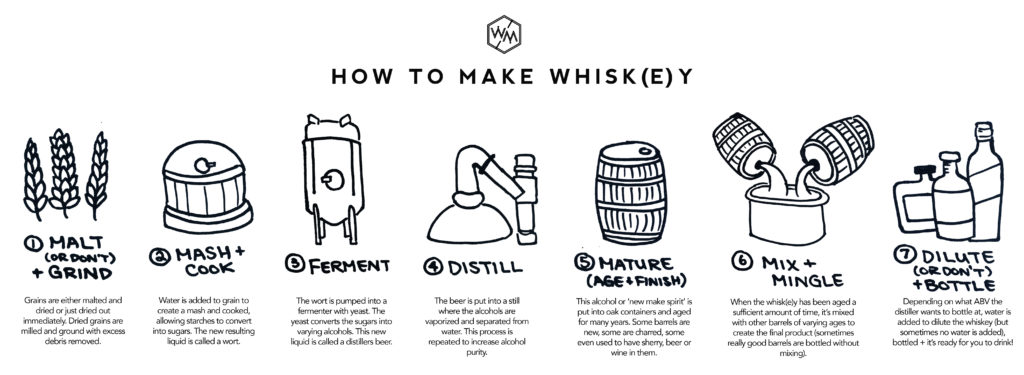
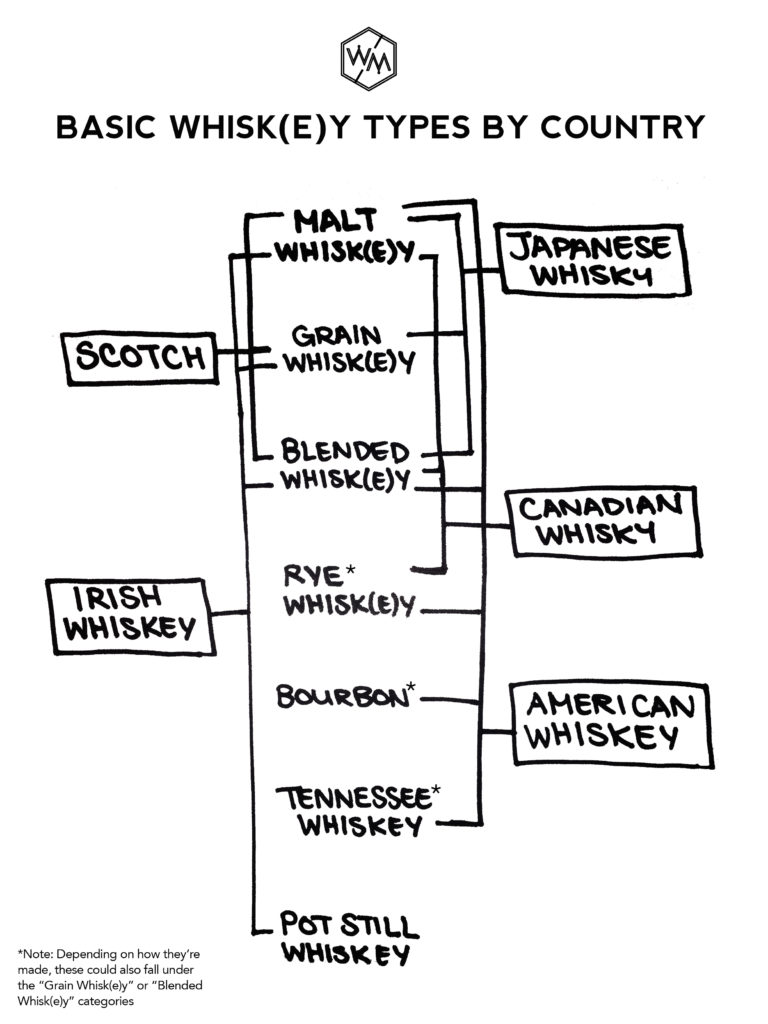
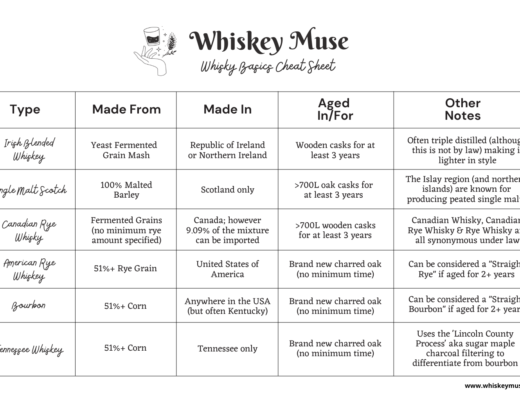
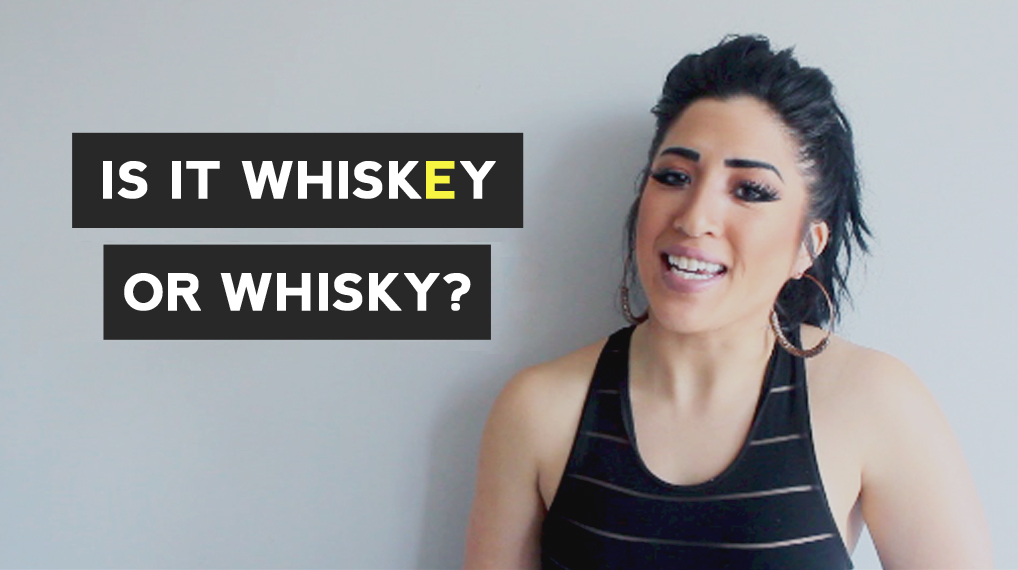
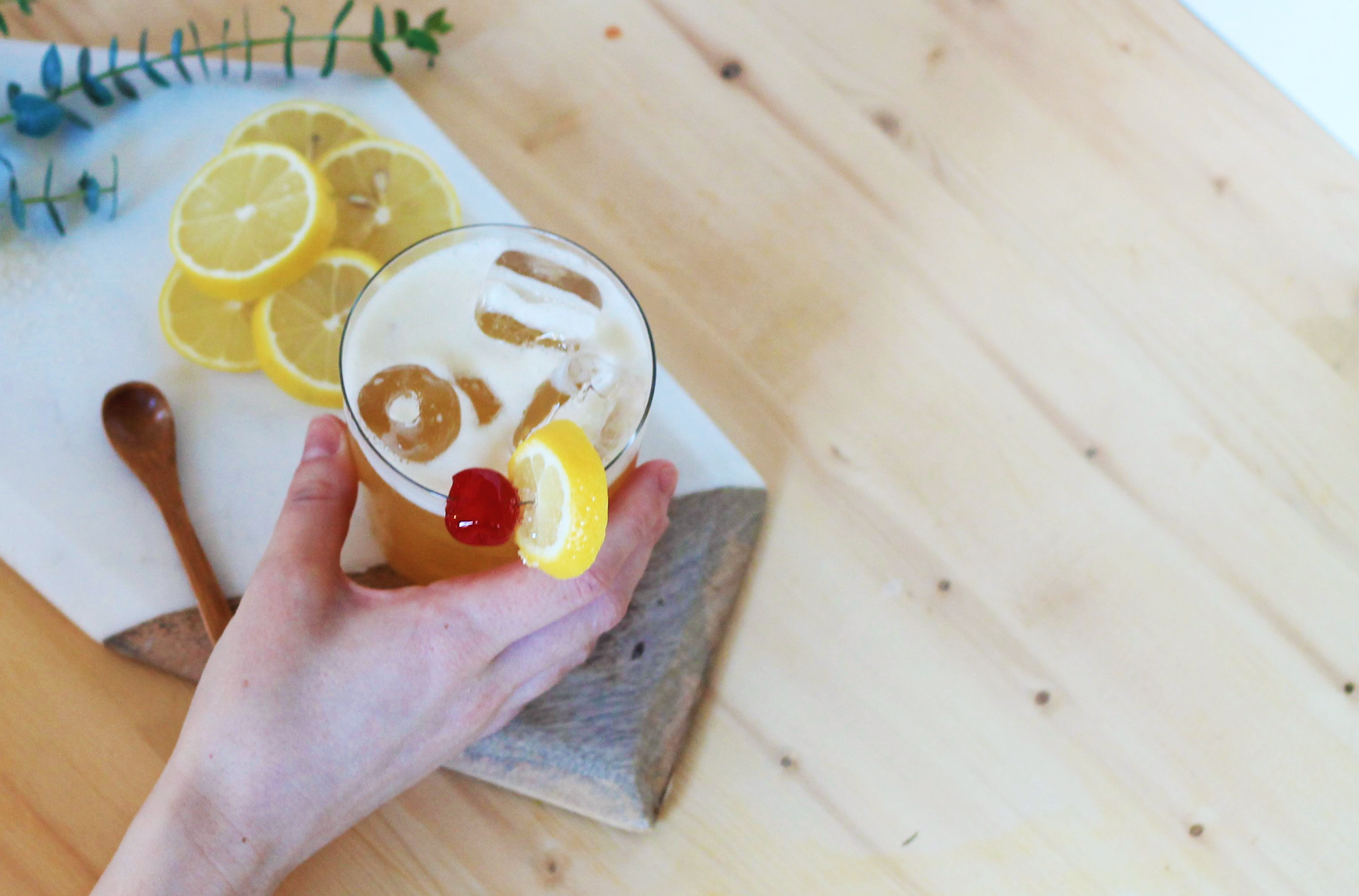

[…] A Comprehensive Beginners Guide to WhiskeyWhiskey for Beginners […]